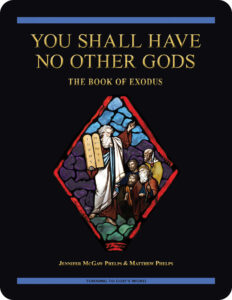 You Shall Have No Other Gods:
You Shall Have No Other Gods:
The Book of Exodus
Lesson 21 Holy Garments for the Priests
the book of Exodus 27:1—28:43
Revised Standard Version Catholic Edition (RSVCE)*
New American Bible Revised Edition (NABRE)*
Catechism of the Catholic Church
Rosarium Virginis Mariae (Rosary of the Virgin Mary)
ex libris (in our library)
glossary for the book of Exodus
cross references in the book of Exodus
next lesson: Consecration of Aaron & His Sons
This material coordinates with Lesson 21 on pages 102–107 in the study book You Shall Have No Other Gods: The Book of Exodus.
And God spoke all these words, saying, ‘I am the LORD your God, who brought you out of the land of Egypt, out of the house of bondage. You shall have no other gods before me. You shall not make for yourself a graven image, or any likeness of anything that is in heaven above, or that is in the earth beneath, or that is in the water under the earth; you shall not bow down to them or serve them; for I the LORD your God am a jealous God, visiting the iniquity of the fathers upon the children to the third and the fourth generation of those who hate me, but showing mercy to thousands of those who love me and keep my commandments.”—the book of Exodus 20:1–6
welcome to our in-depth study of the book of Exodus
We invite interested groups and individuals to check out the sample first lesson from this 28- lesson Turning to
lesson Turning to  God’s Word Catholic Bible study. These online study pages link to our free lesson video overviews, as well as to a glossary and cross references in the biblical text. Other study aids include maps, additional commentary, and prayers based on the primary Scripture in each lesson. You Shall Have No Other Gods: The Book of Exodus has been granted an imprimatur and can be purchased from our website shop. If you have a Bible-related question or comment, click on one of the “ask us your question” or “what do you think” buttons on any online study page.
God’s Word Catholic Bible study. These online study pages link to our free lesson video overviews, as well as to a glossary and cross references in the biblical text. Other study aids include maps, additional commentary, and prayers based on the primary Scripture in each lesson. You Shall Have No Other Gods: The Book of Exodus has been granted an imprimatur and can be purchased from our website shop. If you have a Bible-related question or comment, click on one of the “ask us your question” or “what do you think” buttons on any online study page.
open with prayer
It’s always wise to begin any Bible study with prayer, whether reading the Scriptures alone or meeting with others in a discussion group. You can pray using your own words or use one of the opening prayers on our website. We especially like the following:
Lord Jesus, you promised to send your Holy Spirit to teach us all things.
As we read and study your word today,
allow it to touch our hearts and change our lives. Amen.
let’s review—the book of Exodus 25:1—26:37
In Lesson 20 God Asks the Israelites to Make a Sanctuary, the LORD gives Moses specific instructions for building the ark and the tabernacle. The most valuable thing is the ark, basically a gold-covered box. Its contents are what matters. It’s intended to hold the Ten Commandments, suggesting that the law given to Moses is what should matter most to the Israelites. The value of items radiating out from the ark, sometimes referred to as the ark of the covenant, become of less and less value the more distance between them and the ark and its contents. It isn’t enough, however, for God’s people to carry around the covenant. They also need to keep their end of it.
what did those vestments look like?
This section of the book of Exodus describes in detail how the vestments for the high priest were to be constructed, suggesting that the work might have been written by 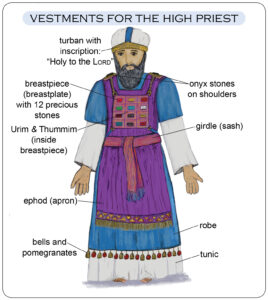 someone with a strong pro-priesthood agenda. It’s obvious that this section of the book of Exodus was written some time after God first gave instructions to Moses. It can be hard to visualize what these vestments might have looked like, but Turning to God’s Word co-founder Tami Palladino has created an illustration based on the biblical text. It’s significant that the vestments are to be constructed of the same materials used to build the tabernacle. Also significant is the emphasis placed on Aaron (the first high priest) bearing the names of all 12 tribes when he serves as the LORD’s minister. The next lesson will explain more about just what that service entails. For now, it’s worth noting that all of the descendants of Jacob are included in the high priest’s mediation for the people. Click on the illustration (right) to enlarge it. The original illustration is on page 106 in You Shall Have No Other Gods: The Book of Exodus.
someone with a strong pro-priesthood agenda. It’s obvious that this section of the book of Exodus was written some time after God first gave instructions to Moses. It can be hard to visualize what these vestments might have looked like, but Turning to God’s Word co-founder Tami Palladino has created an illustration based on the biblical text. It’s significant that the vestments are to be constructed of the same materials used to build the tabernacle. Also significant is the emphasis placed on Aaron (the first high priest) bearing the names of all 12 tribes when he serves as the LORD’s minister. The next lesson will explain more about just what that service entails. For now, it’s worth noting that all of the descendants of Jacob are included in the high priest’s mediation for the people. Click on the illustration (right) to enlarge it. The original illustration is on page 106 in You Shall Have No Other Gods: The Book of Exodus.
 what priestly vestments represent in the Old Testament (56:33)
what priestly vestments represent in the Old Testament (56:33)
In the video overview for this lesson, “Holy Garments for the Priests,” Turning to  God’s Word author Matthew Phelps addresses the most important thing about the priestly garments and why they’re more important than the men who wear them. The crucial clue is that they’re made of materials that are the same as those used to construct the tabernacle. When a person puts on the vestments of the high priest, it signals that he’s entering the presence of God. The tabernacle represents going up on the mountain for closer relationship with God, and putting on the vestments allows an ordinary
God’s Word author Matthew Phelps addresses the most important thing about the priestly garments and why they’re more important than the men who wear them. The crucial clue is that they’re made of materials that are the same as those used to construct the tabernacle. When a person puts on the vestments of the high priest, it signals that he’s entering the presence of God. The tabernacle represents going up on the mountain for closer relationship with God, and putting on the vestments allows an ordinary  man, who may not have his own relationship with God, to enter into the LORD’s presence to perform very particular duties for the whole people. Those duties will be spelled out in the next lesson.
man, who may not have his own relationship with God, to enter into the LORD’s presence to perform very particular duties for the whole people. Those duties will be spelled out in the next lesson.
The Scripture ranges for the videos that accompany this Catholic Bible study from Turning to God’s Word match the Scripture ranges for the sets of questions in You Shall Have No Other Gods: The Book of Exodus. You can follow along as Turning to God’s Word author Matthew Phelps discusses Lesson 21, “Holy Garments for the Priests,” on pages 102–107 in the study book.
vestments made for glory & beauty
Having special clothes for priests clearly sets them apart in their office, which makes sense when we think that the tabernacle and everything connected with it is designed to set apart a space in which people can encounter the LORD. All of these stipulations setting various things apart have to do with sacred spaces and the things used in those spaces, and now the people who serve there. The point of holiness is to set apart the space where God can be encountered. Modern vernacular thinks of holiness as pertaining to actually encountering God in a close relationship. In the Old Testament, holiness describes setting space (and time) apart so to make room for an encounter with God. The section of the book of Exodus focuses on the necessity of rules to make sure the things are separate and different.
ex libris—a papal view of theology of the body
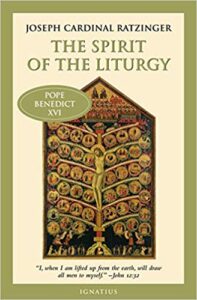
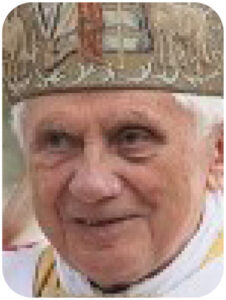 If you’re a chronic overachiever looking for more information about theology of the body, check out The Spirit of the Liturgy by Pope Benedict XVI. This work, which is aimed at helping readers deepen their understanding of the “great prayer of theChurch,” looks at the essence of worship, the Jewish roots of Christian prayer, and the relationship of the liturgy to time and space. The section on liturgical form contains comments about the purpose of priestly vestments. At ex libris—main bookshelf, you can learn more about The Spirit of the Liturgy and other works related to Bible study.
If you’re a chronic overachiever looking for more information about theology of the body, check out The Spirit of the Liturgy by Pope Benedict XVI. This work, which is aimed at helping readers deepen their understanding of the “great prayer of theChurch,” looks at the essence of worship, the Jewish roots of Christian prayer, and the relationship of the liturgy to time and space. The section on liturgical form contains comments about the purpose of priestly vestments. At ex libris—main bookshelf, you can learn more about The Spirit of the Liturgy and other works related to Bible study.
“…Thus the theology of clothing becomes a theology of the body. The body is more than an external dressing up of man—it is part of his very being, of his essential constitution. And yet  this body is subject to decay. It is only a tent. It is provisional. But, at the same time, it is an anticipation of the definitive body, the definitive and complete form of human existence. The liturgical vestment carries this message in itself. It is a ‘further clothing,’ not an ‘unclothing,’ and the liturgy guides us on the way to this ‘further clothing,’ on the way to the body’s salvation in the risen body of Jesus Christ, which is the new ‘house not made with hands, eternal in the heavens’ (the Second Letter to the Corinthians 5:1). The Body of Christ, which we receive in the Eucharist, to which we are united in the Eucharist, saves us from ‘nakedness,’ from the bareness in which we cannot stand before God. In the context of this teaching of Saint Paul, I am very fond of the old formula for the distribution of Holy Communion: ‘The Body of our Lord Jesus Christ preserve thy soul unto everlasting life.’ These words turn the teaching of the Second Letter to the Corinthians 5:1–10 into prayer.”
this body is subject to decay. It is only a tent. It is provisional. But, at the same time, it is an anticipation of the definitive body, the definitive and complete form of human existence. The liturgical vestment carries this message in itself. It is a ‘further clothing,’ not an ‘unclothing,’ and the liturgy guides us on the way to this ‘further clothing,’ on the way to the body’s salvation in the risen body of Jesus Christ, which is the new ‘house not made with hands, eternal in the heavens’ (the Second Letter to the Corinthians 5:1). The Body of Christ, which we receive in the Eucharist, to which we are united in the Eucharist, saves us from ‘nakedness,’ from the bareness in which we cannot stand before God. In the context of this teaching of Saint Paul, I am very fond of the old formula for the distribution of Holy Communion: ‘The Body of our Lord Jesus Christ preserve thy soul unto everlasting life.’ These words turn the teaching of the Second Letter to the Corinthians 5:1–10 into prayer.”
judgment—you could look it up in our archives
 This section in the book of Exodus describes how the high priest is to wear a breast piece of judgment, and how this is to be constructed. To learn more about the word judgment and what role it might play in the duties of the high priest, read Lost in Translation, an online column in which Turning to God’s Word author Matthew Phelps helps readers connect with ideas expressed in the original languages of the Scriptures. New Lost in Translation entries are posted on Mondays, and past entries are archived on our website. Contact us if you’d like to receive Lost in Translation by email every week.
This section in the book of Exodus describes how the high priest is to wear a breast piece of judgment, and how this is to be constructed. To learn more about the word judgment and what role it might play in the duties of the high priest, read Lost in Translation, an online column in which Turning to God’s Word author Matthew Phelps helps readers connect with ideas expressed in the original languages of the Scriptures. New Lost in Translation entries are posted on Mondays, and past entries are archived on our website. Contact us if you’d like to receive Lost in Translation by email every week.
the purpose of the breast piece of judgment might not be what you think
I n the video overview for this lesson, Turning to God’s Word author Matthew Phelps describes the purpose of the high priest always wearing a breast piece of judgment whenever he ministers before the LORD. Consider what the average reader in the present day might expect that breast piece to signify. Consider what else the breastpiece might signify.
n the video overview for this lesson, Turning to God’s Word author Matthew Phelps describes the purpose of the high priest always wearing a breast piece of judgment whenever he ministers before the LORD. Consider what the average reader in the present day might expect that breast piece to signify. Consider what else the breastpiece might signify.
biblical vocabulary: sanctify & sacrifice
Although we think of “sanctify” as a word that means “make holy” and “sacrifice” as a word that means “give up something for God,” both words have the same root. They’re closely related, so sanctification is something that should involve sacrifice. It’s impossible to become holy unless we understand that the object of holiness is to have a relationship with God. Sanctification doesn’t occur unless we make sacrifice to create space for an encounter with God.
WHAT DO YOU THINK about the positioning of the altar before & after Jesus
In the book of Exodus, the altar of sacrifice is to be made of bronze and placed outside the tabernacle. In our churches, the altar has moved to the place of prominence. It’s helpful for Catholics to consider why it is that we’ve moved the altar, and especially to consider why it’s been moved inside Christian churches.
In our churches, the altar has moved to the place of prominence. It’s helpful for Catholics to consider why it is that we’ve moved the altar, and especially to consider why it’s been moved inside Christian churches.
? The word altar means “table.” What is the purpose of the bronze altar in the book of Exodus?
? What other altar exists in connection with the tabernacle?
? Where is this second altar located, and what is its purpose?
? Where is the altar located in your parish church?
? What is the purpose of that parish altar?
? How are Catholics supposed to view the altar, and how is this tied to Jesus?
sanctuary lamps
Most Catholics are aware that they can locate the tabernacle, the name given to the place of repose for  the sacrament of the Eucharist, by looking for a red lamp in any Catholic church. Wherever this lamp appears, the tabernacle is nearby. Because Catholics believe in the real presence of Christ in the sacrament of the Eucharist, the red lamp signifies the place where God can be found. Some Protestant churches also contain sanctuary lamps, but their position doesn’t indicate the presence of the Blessed Sacrament. It does serve to indicate that God is present in those churches.
the sacrament of the Eucharist, by looking for a red lamp in any Catholic church. Wherever this lamp appears, the tabernacle is nearby. Because Catholics believe in the real presence of Christ in the sacrament of the Eucharist, the red lamp signifies the place where God can be found. Some Protestant churches also contain sanctuary lamps, but their position doesn’t indicate the presence of the Blessed Sacrament. It does serve to indicate that God is present in those churches.
? Consider the primary difference between the presence of God found in Protestant churches and the real presence of Christ in the sacrament of the Eucharist. How is this difference reflected in the Catholic Mass?
? Why do you think that Catholics refer to the place in which the Blessed Sacrament is reposed as a tabernacle?
? Where is the tabernacle in your parish church?
? What is suggested by that position?
the best Catholic commentary about Scripture
 To find out more about how Church teaching is supported by Scripture passages in You Shall Have No Other Gods: The Book of Exodus, check out the Index of Citations in the Catechism of the Catholic Church. Links (to the primary Scripture passages in the lesson (Revised Standard Version Catholic Edition [RSVCE*]) and relevant paragraphs in the Catechism are provided here. Not every passage in the biblical text for this Catholic Bible study is referenced in a Catechism paragraph, however, including the passage in this lesson from the book of Exodus 27:1—28:43.
To find out more about how Church teaching is supported by Scripture passages in You Shall Have No Other Gods: The Book of Exodus, check out the Index of Citations in the Catechism of the Catholic Church. Links (to the primary Scripture passages in the lesson (Revised Standard Version Catholic Edition [RSVCE*]) and relevant paragraphs in the Catechism are provided here. Not every passage in the biblical text for this Catholic Bible study is referenced in a Catechism paragraph, however, including the passage in this lesson from the book of Exodus 27:1—28:43.
ways our glossary might prove helpful
In addition to providing extra information about geographical locations, our glossary also points out  when a person or place is mentioned in the biblical text under more than one name or more than one spelling. If you can remember a name but aren’t sure in which lesson it shows up, you can find it in the glossary, which lists every proper noun that appears in the biblical text for every lesson in You Shall Have No Other Gods: The Book of Exodus.
when a person or place is mentioned in the biblical text under more than one name or more than one spelling. If you can remember a name but aren’t sure in which lesson it shows up, you can find it in the glossary, which lists every proper noun that appears in the biblical text for every lesson in You Shall Have No Other Gods: The Book of Exodus.
to learn more, read more Scripture
If you’re having difficulty with a particular passage of Scripture, it can be helpful to read the relevant  cross references—but looking these up can take time. To make that easier, we’ve compiled the cross references from the Revised Standard Version Second Catholic Edition (RSV2CE)—the translation that we reprint in our study books. That list can be found at the top of every online study page accompanying this study, and it includes links to each of the cross references in the primary biblical text for You Shall Have No Other Gods: The Book of Exodus.
cross references—but looking these up can take time. To make that easier, we’ve compiled the cross references from the Revised Standard Version Second Catholic Edition (RSV2CE)—the translation that we reprint in our study books. That list can be found at the top of every online study page accompanying this study, and it includes links to each of the cross references in the primary biblical text for You Shall Have No Other Gods: The Book of Exodus.
don’t forget about our indexes & extra online material

 If you’re trying to locate information about a specific Scripture passage, you can look it up in the index at the back of the study book or sample lesson. If you want to find a particular commentary, you can look up its title in the topics index. To learn more about another book of the Bible for which there’s a Turning to God’s Word study, visit the online study directories to read the commentaries and watch any accompanying videos. Finally, if you have a question or would like to make a comment about any of our studies, you can use one of the “ask us your question” or “what do you think” buttons to email our authors.
If you’re trying to locate information about a specific Scripture passage, you can look it up in the index at the back of the study book or sample lesson. If you want to find a particular commentary, you can look up its title in the topics index. To learn more about another book of the Bible for which there’s a Turning to God’s Word study, visit the online study directories to read the commentaries and watch any accompanying videos. Finally, if you have a question or would like to make a comment about any of our studies, you can use one of the “ask us your question” or “what do you think” buttons to email our authors.
ex libris—Church documents & books about religious topics
Link to magisterial documents referred to in our Bible studies at ex libris—magisterial documents.  This listing includes significant recent encyclicals as well as a number of historical Church documents. Recommended books related to Scripture study can be found at ex libris—main bookshelf.
This listing includes significant recent encyclicals as well as a number of historical Church documents. Recommended books related to Scripture study can be found at ex libris—main bookshelf.
wondering how to pronounce some of these words?
The following link is to a reading from the New International Version (NIV) Bible. To listen, open the link and click on the audio icon above the printed text. Although not taken from the translations used in our study materials, the NIV reading provides an audio guide to pronunciation of words in this lesson’s primary biblical text. A close online version of the translation of the Bible used in Catholic liturgy in the United States as well as an audio guide for daily Mass readings for the current month can be found on the website of the United States Conference of Catholic Bishops (USCCB).
the book of Exodus 27:1—28:43 (NIV)
 close with Bible-based prayer related to this lesson
close with Bible-based prayer related to this lesson
Many of our Catholic study groups like to conclude their discussions with a prayer based on the scriptural focus of their lesson, and some participants include Scripture-specific prayer in their individual study. If you’re uncomfortable composing your own Bible-based prayers, you can follow our four easy steps. If you prefer, you can use the following short prayer based on this lesson’s text from the book of Exodus.
O God, you ask your people to consecrate themselves
and be holy as you are holy.
Enable us to set ourselves apart from worldly temptations
and everyday concerns in order to better serve you.
We ask this in the name of Jesus Christ,
who, although human, remained sinless. Amen.
Lesson 22 Consecration of Aaron & His Sons, the book of Exodus 29:1–46
Lesson 20 God Asks the Israelites to Make a Sanctuary, the book of Exodus 25:1—26:37
you also may like our study of Scripture & the Rosary (digital only)
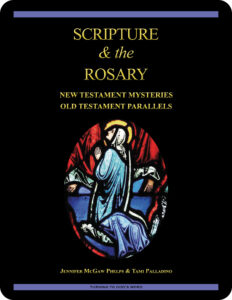 Scripture & the Rosary: New Testament Mysteries, Old Testament Parallels, a 26-lesson Catholic Bible study with an imprimatur, looks at the biblical foundations of the Rosary. The study includes lessons on Pope St. John Paul II’s Rosarium Virginis Mariae (Rosary of the Virgin Mary), the Apostles’ Creed, and the Luminous Mysteries as well as the original 15 Mysteries of the Rosary. Color photographs of stained glass windows depict key scenes in the lives of Jesus and Mary. Free digital lessons rotate throughout the year on our website.
Scripture & the Rosary: New Testament Mysteries, Old Testament Parallels, a 26-lesson Catholic Bible study with an imprimatur, looks at the biblical foundations of the Rosary. The study includes lessons on Pope St. John Paul II’s Rosarium Virginis Mariae (Rosary of the Virgin Mary), the Apostles’ Creed, and the Luminous Mysteries as well as the original 15 Mysteries of the Rosary. Color photographs of stained glass windows depict key scenes in the lives of Jesus and Mary. Free digital lessons rotate throughout the year on our website.
start a Turning to God’s Word Bible study
 Thank you for your interest in You Shall Have No Other Gods: The Book of Exodus.
Thank you for your interest in You Shall Have No Other Gods: The Book of Exodus.  Information about beginning a Turning to God’s Word Bible study can be found at start a Bible study. Tami, Matthew, and I are available to answer your questions and to offer support. You may use this email to contact us directly if you’re interested in starting a Turning to God study or in having your study schedule listed with other TtGW study groups on our website. —Jennifer
Information about beginning a Turning to God’s Word Bible study can be found at start a Bible study. Tami, Matthew, and I are available to answer your questions and to offer support. You may use this email to contact us directly if you’re interested in starting a Turning to God study or in having your study schedule listed with other TtGW study groups on our website. —Jennifer
*There are seven deuterocanonical books in the Old Testament—the Books of Tobit, Judith, Wisdom, Sirach, Baruch, and First and Second Maccabees, as well as some passages in the Books of Esther and Daniel. Protestants usually refer to these works as “apocryphal,” a word that means “outside the (Protestant) canon” because they’re excluded from most Protestant Bibles. The word “deuterocanonical” means “second canon”; Catholics use that word to refer to any section of the Catholic Old Testament for which there are no extant, or existing, Hebrew manuscripts. All of the deuterocanonical books appear in the Septuagint, the earliest remaining versions of which date to the 1st century B.C. This Greek translation of the Old Testament was in common use by Jews at the time of Jesus. Learn more by reading How Do Catholic & Protestant Bibles Differ?
Turning to God’s Word printed Bible studies use the 2006 Revised Standard Version Second Catholic Edition (RSV2CE) translation for all Scripture references except those to the Psalms, which are taken from The Abbey Psalms and Canticles, prepared by the Benedictine monks of Conception Abbey and published in 2020 by the United States Conference of Catholic Bishops (USCCB). All Scripture links for the online study pages for You Shall Have No Other Gods: The Book of Exodus are to the 1966 Revised Standard Version Catholic Edition (RSVCE) translation. The New International Version (NIV) audio recordings follow the same chapter and verse numbering as the RSV Catholic translations, but the NIV translation doesn’t include the deuterocanonical books and passages.
The 1966 RSVCE uses archaic pronouns and verb forms such as “thee,” “thou,” “didst” in the Psalms and in direct quotations attributed to God. The 2006 RSV2CE replaces those with more accessible English. The few significant translation changes in the RSV2CE include rendering almah as “virgin” in the Book of Isaiah 7:14 and restoring the term “begotten” in the Gospel According to John 3:16.
Numbering varies for some passages in this Bible study. Turning to God’s Word studies (print and digital) follow the numbering in the Revised Standard Version Catholic translations (RSV2CE and RSVCE). Discrepancies in the New American Bible Revised Edition (NABRE) are noted in the Index of Scripture Citations in the study book and the online sample.
 You can learn more about the Psalms by viewing a sample lesson from the Turning to God’s Word Catholic Bible study Sing a New Psalm: Communicating with God Through the Prayers of the Church—Volume I: Lauds & Vespers. The second part of that study, Sing a New Psalm: Communicating with God Through the Prayers of the Church—Volume II: Vigils, Day Prayer & Compline, is scheduled for publication in 2025. Some verse numbers may vary in different translations of the Psalms.
You can learn more about the Psalms by viewing a sample lesson from the Turning to God’s Word Catholic Bible study Sing a New Psalm: Communicating with God Through the Prayers of the Church—Volume I: Lauds & Vespers. The second part of that study, Sing a New Psalm: Communicating with God Through the Prayers of the Church—Volume II: Vigils, Day Prayer & Compline, is scheduled for publication in 2025. Some verse numbers may vary in different translations of the Psalms.
